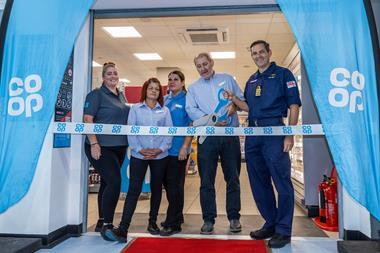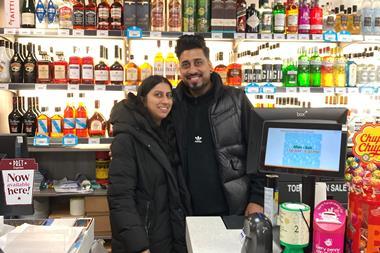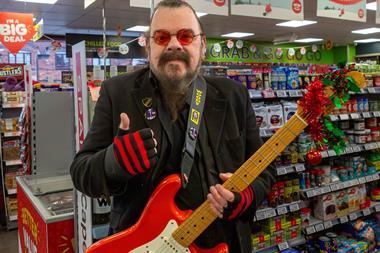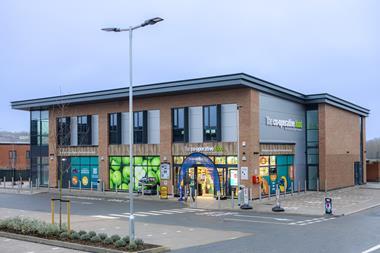Convenience store retailers are ditching traditional advertising methods in favour of innovative new revenue-boosting systems. Gaelle Walker investigates
It's lunchtime on London's bustling Holloway road and a gaggle of people are standing transfixed outside the doors of independent retailer Shalil Bhattessa's Budgens-branded store.
They are staring, saucer-eyed, at two large street-facing LCD TV screens which flash a continuous stream of appetising images, from succulent salt beef sandwiches, to creamy cappuccinos and warm sugary pastries onto the street outside the store.
With grumbling stomachs and watering mouths, the shoppers tear themselves away from the screens and hotfoot it inside the store, where they descend upon its exquisitely merchandised food to go counter, and set the tills ringing.
Shalil is used to this kind of behaviour. It's been happening ever since he installed his in-store TV advertising system two months ago.
"The new screens are proving to be hugely effective," he says. "People who might not have been planning to pop into the store before can't help themselves once they have seen what's on offer through the screens."
And Shalil doesn't just televise images of his great deli and food-to- go offer. He also uses the screens to highlight specific product promotions and local events.
"We show footage of some of our farmers and suppliers to highlight the provenance of our groceries," he explains, adding "the screens are one of the most effective means of driving footfall and boosting sales that I have ever come across in retail."
IGD predicts that in-store TV advertising will become the norm in the next few years, as traditional paper-based point-of-sale messages fall by the wayside.
Unlike a paper poster, screen-based messages can be easily tailored to a specific time of day or to certain parts of the store, assisting in delivering the most appropriate message to the dominant shopper mix present at that time.
Additionally, messages can be controlled by clusters of stores to assist with local marketing.
"I see in-store media as an essential tool to promote my store activities directly to customers," says Luton-based retailer Kishor Patel, who installed digital media solutions in three of his Nisa Local stores earlier this year.
"My customers are informed of all my promotions and what's happening in their community."
As well as increased sales, Kishor also receives 50% net of all revenue generated from any advertising that appears on the screens, says the Big Media Group, which installed his system.
The company took to the streets prior to installation and searched the local area for potential businesses which would be keen to promote their services on the screens.
Darren Briggs, managing director of the Big Media Group, estimates that a c-store with a good local business base could take up to £3,000 a year purely in advertising revenue.
While there are many schools of thought on the most effective place to put the screens, Briggs believes the best is at the point of sale.
"That's the only place we can guarantee customers will see them," he says. "Positioning them in particular aisles is less effective, as not all shoppers visit every part of the store, but everyone has to wait at the checkout."
The screens also help break the monotony of queuing at the till, which in turn could lead to repeat visits, he adds.
Spar, which adopted in-store TV earlier in the year, says that its screen network is already proving its worth.
Analysis of epos data shows an increase of 2.3% in total store sales, including massive uplifts for specific product categories such as beer, wines and spirits, up 4.7%, and food to go, up 7.8%.
"As our market becomes increasingly competitive, I see our in-store TV network as a valuable sales tool to help grow our business," says Conrad Davies, who runs a thriving Spar store in Pwllheli, North Wales. "The screens give the store a real wow factor."
The network's content has been developed with both Spar's central office team and Tates, to support the in-store marketing strategy and drive customer spend. On-screen content includes a Real Deals programme, and own brand, food to go and seasonal event activity, as well as third-party advertising.
Screens can also be used for health and safety and product recall notifications when required.
Point Four is another company active in this sector. The digital media solutions provider is on track with its ambitious plans to roll out its in-store network to more than 10,000 retailers in 2008.
But it's not only screens that offer an opportunity. Spar has been busy developing another popular medium: radio. Experts believe that the medium of sound can be infinitely more effective in influencing consumer behaviour than visual messages, due to its subliminal qualities.
"Radio advertising touches customers in ways that visual advertising quite simply cannot," says Diane Whalley, head of business development for TEAMtalk Broadcast, the company which produces Costcutter InTune Radio.
"For a start, customers are exposed to it all around the store and not just in particular areas, making it far more effective."
Spar promotions manager Devraj Dhillon agrees. "As well as driving promotional awareness, in-store radio can have a massive impact on a store's ambience. Done correctly, it can provide real theatre and communicate your brand's values," he says.
Devraj is looking at ways to drive impulse purchases by tailoring promotions to specific sporting or cultural events.
However, the key to a really successful in-store radio system, says Devraj, is the music that's played alongside the various promotions, advertisements and messages.
Studies have shown that music alone has the potential to increase sales by as much as 10%.
The right kind of music played at the right time of day can create a unique environment and give a significant boost to a store's energy levels, leading to an increased customer stay time.
Devraj recommends playing more upbeat pop tunes in the morning when stores are often busy with mums doing their weekly shops, and then to adopt a more calming tone in the evening, when the businessmen and women come in to buy their dinner or a bottle of wine.
The right kind of music can also help to increase customer spend. A recent study by Dr Adrian North, psychology lecturer at the University of Leicester, found that customers spent more money when classical music was piped over an in-store PA system, compared with easy-listening music, or no music at all.
"Customers were prepared to spend more money when the music promoted an upmarket atmosphere," said Dr North. "When music provided a tacky atmosphere, or an absence of music led to no clear cut image, then this had a detrimental effect on the amount customers were prepared to spend," he added.
In another study, North set up a special aisle with only French and German wines at a branch of his local grocery store.
Stereotypically French and German music was played in the aisle on alternate days over a two- week period. The results were astounding. On the days that French music was played, the French wine outsold the German by five bottles to one, and when German music was played, then German wine outsold the French by two bottles to one. "The study revealed that people were far more likely to buy wine associated with the music that was playing," says North. "If a store plays music that 'fits' a product, then people are more likely to buy that product."
When coupled with traditional promotional techniques such as in-store tastings, the results of such audio alchemy can be a significant increase in sales.
Another innovative form of advertising set to change the face of UK high streets is shutter advertising, or 'shutter art' as it's more affectionately known. Popular beer brand Brahma started trialling the technique with a range of c-stores and newsagents earlier this year and is receiving positive feedback.
Not only do the bright designs transform dull metal security shutters into mini works of art, but the advertising also provides another easy source of income for retailers.
So what's next? Conveyor belt advertising is one revenue-boosting trend set to add a flash of colour to UK tills in the coming months, but perhaps the most hotly anticipated medium is the mobile phone. The potential for this form of advertising is endless, says Adrian Williams, senior business analyst at IGD, and it has captured the imaginations of retailers and advertisers alike. Just last month Shop Scan Save, the new mobile phone-based promotions scheme for c-stores, was launched to much fanfare.
Consumers who sign up to the scheme receive barcode SMS vouchers on their mobile phones, which they can redeem when scanned on a PayPoint terminal. And Williams expects to see many more advances of the mobile type in the coming years.
With all these technological milestones on the horizon, it's safe to say that the future's not just bright, it's technicoloured.
It's lunchtime on London's bustling Holloway road and a gaggle of people are standing transfixed outside the doors of independent retailer Shalil Bhattessa's Budgens-branded store.
They are staring, saucer-eyed, at two large street-facing LCD TV screens which flash a continuous stream of appetising images, from succulent salt beef sandwiches, to creamy cappuccinos and warm sugary pastries onto the street outside the store.
With grumbling stomachs and watering mouths, the shoppers tear themselves away from the screens and hotfoot it inside the store, where they descend upon its exquisitely merchandised food to go counter, and set the tills ringing.
Shalil is used to this kind of behaviour. It's been happening ever since he installed his in-store TV advertising system two months ago.
"The new screens are proving to be hugely effective," he says. "People who might not have been planning to pop into the store before can't help themselves once they have seen what's on offer through the screens."
And Shalil doesn't just televise images of his great deli and food-to- go offer. He also uses the screens to highlight specific product promotions and local events.
"We show footage of some of our farmers and suppliers to highlight the provenance of our groceries," he explains, adding "the screens are one of the most effective means of driving footfall and boosting sales that I have ever come across in retail."
IGD predicts that in-store TV advertising will become the norm in the next few years, as traditional paper-based point-of-sale messages fall by the wayside.
Unlike a paper poster, screen-based messages can be easily tailored to a specific time of day or to certain parts of the store, assisting in delivering the most appropriate message to the dominant shopper mix present at that time.
Additionally, messages can be controlled by clusters of stores to assist with local marketing.
"I see in-store media as an essential tool to promote my store activities directly to customers," says Luton-based retailer Kishor Patel, who installed digital media solutions in three of his Nisa Local stores earlier this year.
"My customers are informed of all my promotions and what's happening in their community."
As well as increased sales, Kishor also receives 50% net of all revenue generated from any advertising that appears on the screens, says the Big Media Group, which installed his system.
The company took to the streets prior to installation and searched the local area for potential businesses which would be keen to promote their services on the screens.
Darren Briggs, managing director of the Big Media Group, estimates that a c-store with a good local business base could take up to £3,000 a year purely in advertising revenue.
While there are many schools of thought on the most effective place to put the screens, Briggs believes the best is at the point of sale.
"That's the only place we can guarantee customers will see them," he says. "Positioning them in particular aisles is less effective, as not all shoppers visit every part of the store, but everyone has to wait at the checkout."
The screens also help break the monotony of queuing at the till, which in turn could lead to repeat visits, he adds.
Spar, which adopted in-store TV earlier in the year, says that its screen network is already proving its worth.
Analysis of epos data shows an increase of 2.3% in total store sales, including massive uplifts for specific product categories such as beer, wines and spirits, up 4.7%, and food to go, up 7.8%.
"As our market becomes increasingly competitive, I see our in-store TV network as a valuable sales tool to help grow our business," says Conrad Davies, who runs a thriving Spar store in Pwllheli, North Wales. "The screens give the store a real wow factor."
The network's content has been developed with both Spar's central office team and Tates, to support the in-store marketing strategy and drive customer spend. On-screen content includes a Real Deals programme, and own brand, food to go and seasonal event activity, as well as third-party advertising.
Screens can also be used for health and safety and product recall notifications when required.
Point Four is another company active in this sector. The digital media solutions provider is on track with its ambitious plans to roll out its in-store network to more than 10,000 retailers in 2008.
But it's not only screens that offer an opportunity. Spar has been busy developing another popular medium: radio. Experts believe that the medium of sound can be infinitely more effective in influencing consumer behaviour than visual messages, due to its subliminal qualities.
"Radio advertising touches customers in ways that visual advertising quite simply cannot," says Diane Whalley, head of business development for TEAMtalk Broadcast, the company which produces Costcutter InTune Radio.
"For a start, customers are exposed to it all around the store and not just in particular areas, making it far more effective."
Spar promotions manager Devraj Dhillon agrees. "As well as driving promotional awareness, in-store radio can have a massive impact on a store's ambience. Done correctly, it can provide real theatre and communicate your brand's values," he says.
Devraj is looking at ways to drive impulse purchases by tailoring promotions to specific sporting or cultural events.
However, the key to a really successful in-store radio system, says Devraj, is the music that's played alongside the various promotions, advertisements and messages.
Studies have shown that music alone has the potential to increase sales by as much as 10%.
The right kind of music played at the right time of day can create a unique environment and give a significant boost to a store's energy levels, leading to an increased customer stay time.
Devraj recommends playing more upbeat pop tunes in the morning when stores are often busy with mums doing their weekly shops, and then to adopt a more calming tone in the evening, when the businessmen and women come in to buy their dinner or a bottle of wine.
The right kind of music can also help to increase customer spend. A recent study by Dr Adrian North, psychology lecturer at the University of Leicester, found that customers spent more money when classical music was piped over an in-store PA system, compared with easy-listening music, or no music at all.
"Customers were prepared to spend more money when the music promoted an upmarket atmosphere," said Dr North. "When music provided a tacky atmosphere, or an absence of music led to no clear cut image, then this had a detrimental effect on the amount customers were prepared to spend," he added.
In another study, North set up a special aisle with only French and German wines at a branch of his local grocery store.
Stereotypically French and German music was played in the aisle on alternate days over a two- week period. The results were astounding. On the days that French music was played, the French wine outsold the German by five bottles to one, and when German music was played, then German wine outsold the French by two bottles to one. "The study revealed that people were far more likely to buy wine associated with the music that was playing," says North. "If a store plays music that 'fits' a product, then people are more likely to buy that product."
When coupled with traditional promotional techniques such as in-store tastings, the results of such audio alchemy can be a significant increase in sales.
Another innovative form of advertising set to change the face of UK high streets is shutter advertising, or 'shutter art' as it's more affectionately known. Popular beer brand Brahma started trialling the technique with a range of c-stores and newsagents earlier this year and is receiving positive feedback.
Not only do the bright designs transform dull metal security shutters into mini works of art, but the advertising also provides another easy source of income for retailers.
So what's next? Conveyor belt advertising is one revenue-boosting trend set to add a flash of colour to UK tills in the coming months, but perhaps the most hotly anticipated medium is the mobile phone. The potential for this form of advertising is endless, says Adrian Williams, senior business analyst at IGD, and it has captured the imaginations of retailers and advertisers alike. Just last month Shop Scan Save, the new mobile phone-based promotions scheme for c-stores, was launched to much fanfare.
Consumers who sign up to the scheme receive barcode SMS vouchers on their mobile phones, which they can redeem when scanned on a PayPoint terminal. And Williams expects to see many more advances of the mobile type in the coming years.
With all these technological milestones on the horizon, it's safe to say that the future's not just bright, it's technicoloured.






















No comments yet